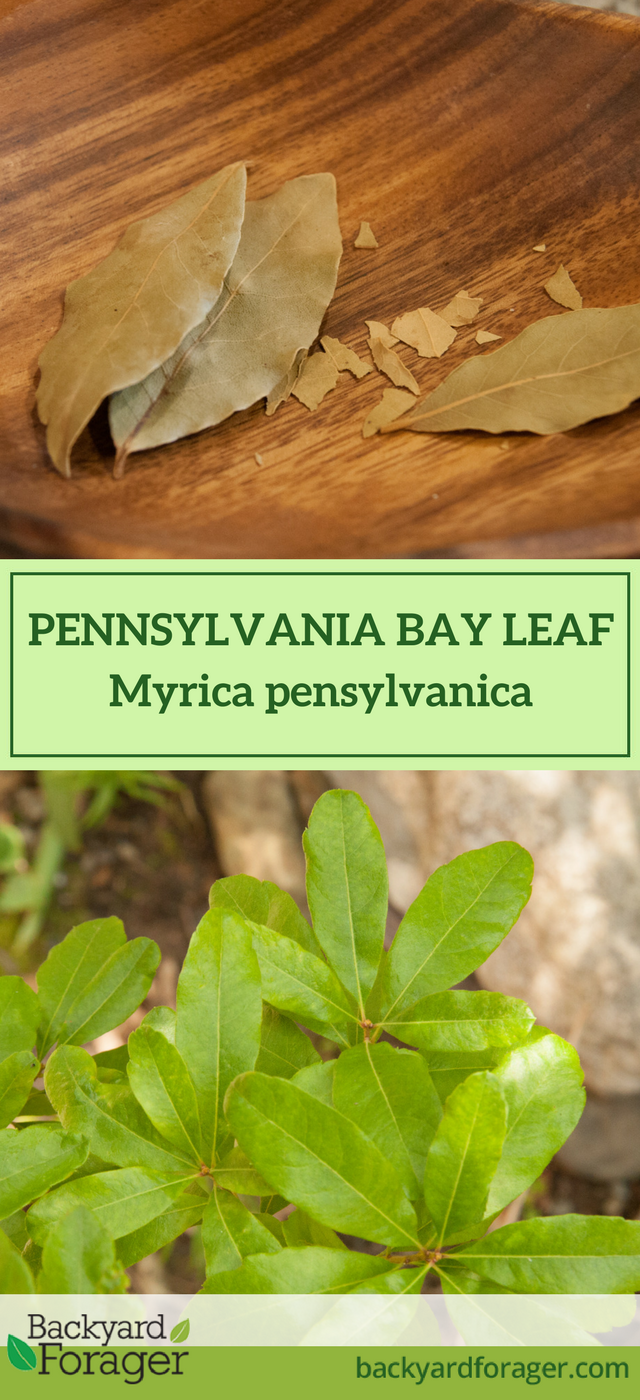
Let me start by saying that Myrica pensylvanica is not a misspelling. (Yes, I’m a bad speller, but I looked this one up.) I don’t know why the botanical name is spelled with only one n when the state is spelled with two, but whoever made that mistake made it a long time ago and taxonomists are not going to go back and change it now. (Taxonomists are a stubborn bunch.) Let’s just call it Pennsylvania bay leaf.
This plant is native to small pockets of the northeastern United States, although, interestingly, not in much of Pennsylvania. It’s generally a coastal plant and tolerates salt spray well. I don’t get to forage on the coast very often, but Pennsylvania bay leaf is an attractive plant, so I planted one in my garden. I guess that means this technically isn’t a foraged herb, but the first time I harvested it was in the wild, so I still think of it as a wild edible.
The gray-blue fruits of Pennsylvania bay leaf are pretty, attract birds to the garden, and can be used in making soaps and candles. Pennsylvania bay is a dioecious plant, which means male and female flowers grow on separate plants, as with hollies. So if you’re in it for the waxy berries, you’ll need both a male plant (to pollinate) and a female plant (to bear fruit). I only have one bayberry in my garden, because I’m interested in flavor, not candlemaking (the waxy berries are used to make candles). Male and female shrubs produce equally flavorful foliage.
Pennsylvania bay leaf is as attractive as it is tasty. Leaves are glossy, bright green, and slightly wavy along the margins. Drying intensifies the flavor, so harvest fresh leaves, then dry them for year-round use. You can either dry individual leaves in a dehydrator at 95F, or bundle the stems together with an elastic band and hang them somewhere dry and out of direct sun. When drying is complete, store the dried bayberry leaves in a glass jar with a tight fitting lid.
You can use Pennsylvania bay leaf leaves in any recipe that calls for bay leaf (Laurus nobilis), but the flavor of Pennsylvania bay is less strong, so use twice as many leaves.

What month(s) do you harvest myrica pensylvanica leaves? Some plants need specific times.
Yes, some plants have specific harvest times, but the leaves of Myrica pensylvanica can be harvested any time they’re green and flexible. I harvest them spring through fall, until they start to turn brown.
Thanks for the great info (came across your page doing a search on how to dry Northern Bayberry leaves). I just wanted to add that, while M. pensylvanica is typically dioecious, there are some that are monoecious: https://hvp.osu.edu/pocketgardener/source/description/my_anica.html. I purchased one three years ago from our local (Long Island, NY) native plant initiative. It was too young for them to tell me if it was male or female, so I was told to wait until the following year at which time they said they should be able to tell. As far as I know, no one in my neighborhood has a Bayberry Bush for cross pollinisation, yet in its second season my lone little bush produced some berries! This year, its third season, it has grown tons, is spreading, and has a copious amount of berries on it! Obviously I wouldn’t recommend counting on a single female plant for anyone desiring berries, but sometimes you get lucky – or you can ask your local nursery if the specimens they’re selling are monoecious.
Thanks for the link. The article says that most commercially available plants are monoecious, which makes sense, since people who buy the plant probably want the ornamental fruit. But even if you had a dioecious plant, it could cross pollinate with a plant a mile away. You wouldn’t necessarily even know that other plant was there. They don’t call them busy bees for nothing!